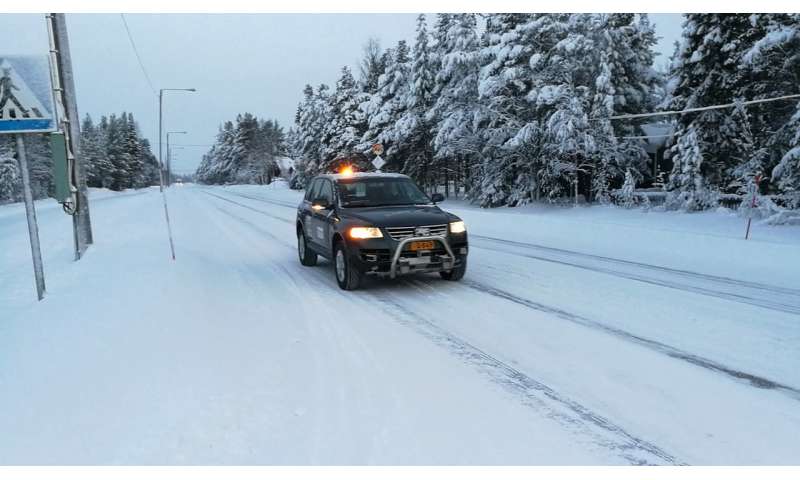Martti is the first Finnish robot car to challenge snow and ice

Martti, the robot car developed by VTT Technical Research Centre of Finland, is the first automated car to have driven fully autonomously on a real snow-covered road. On top of that, it also succeeded in making a new speed record of 40 km/h on the Aurora E8 intelligent road in Muonio, probably setting a new unofficial world record as well.
Martti is a research vehicle developed on the chassis of Volkswagen Touareg. Like its counterpart Marilyn, it is equipped with cameras, antennas, sensors and laser scanners. The number and placement of sensors differs between the vehicles. For example, Martti has three laser scanners sensing the environment only in front of the car, whereas its spouse Marilyn has two scanners looking forwards and one looking backwards.
"When in spring 2017 we, the researchers, taught the automated car Marilyn to drive, this autumn it has been teaching us on how to make Martti such that it can get along with its spouse, and follow GPS and positioning information on its route. Martti has been designed for demanding weather conditions and Marilyn shines as the queen of urban areas," says project manager Matti Kutila from VTT's RobotCar Crew, describing the couple.
On the intelligent road of Muonio, Martti was also given intensive training. "It clearly has a very determined mindset, and after a persistent 24-hour training session, it started functioning. Earlier, Marilyn required a lot more work, because its control software was created from scratch. Martti uses the same software, which did no longer require more than minor adjustments," says Ari Virtanen, who was in charge of building the car and its equipment.
Martti made its speed record, when it was allowed to pick up speed after having felt its way for a little while. "It probably also made a new world record in fully automated driving, making 40 km/h in a snowfall on snow-covered terrain without lane markings. It could have had even more speed, but in test driving it is programmed not to exceed the limit of 40 km/h," Kutila points out. The amazing drive was implemented by Pasi Pyykönen, Ari Virtanen and Rainer Täppinen.
The next step for VTT's autonomous cars will be changing the wavelengths of the optical components, increasing the resolution of the radar, and building more intelligence in the software monitoring the capabilities of the sensors. These are intended to enhance the vehicle's functioning capacity step by step also on slippery road surfaces, where concealed edge of the road or fog may obstruct visibility.
Different scenarios are added all the time in the development of the autonomous cars (such as cities, main roads, snow, exit ramps) that the car can manage, while increasing the driving speed and managing even demanding weather conditions with intelligence.
Next, Martti will spend a well-deserved Christmas holiday, but Marilyn will be on call between Christmas and New Year, preparing for its first mission abroad, a trip to Germany in May. Before mid-January, Martti will be equipped with communications modules which allow it to communicate with digital transport infrastructure. So far it has been able to communicate with its spouse Marilyn only.
VTT's automated cars are intensely involved in the development of the 5G system, taking advantage of the opportunities it provides for automated driving through, for example, the 5G-SAFE project, which is part of Tekes' Challenge Finland programme. VTT works in close collaboration with the European automotive industry in the development of automation for demanding weather conditions.
"We already have at our disposal an intelligent roadside unit, capable of feeding local information for the insatiable needs of Martti and Marilyn. This cart dubbed MARSU contains measuring devices for friction data and a communications module serving as a base station. Furthermore, next spring one of our vehicles can also be spotted in forest environments, when Marilyn and Martti get a new friend capable of tackling all terrains," Kutila reveals.
Provided by VTT Technical Research Centre of Finland